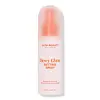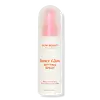What's inside
What's inside
 Key Ingredients
Key Ingredients

 Benefits
Benefits

 Concerns
Concerns

 Ingredients Side-by-side
Ingredients Side-by-side

Water
Skin ConditioningPvp
Emulsion StabilisingPentylene Glycol
Skin ConditioningGlycerin
HumectantNiacinamide
SmoothingPhenoxyethanol
PreservativePoloxamer 407
EmulsifyingPolyglyceryl-10 Laurate
Skin ConditioningButylene Glycol
HumectantSodium Hyaluronate
HumectantEthylhexylglycerin
Skin ConditioningRosmarinus Officinalis Leaf Extract
AntimicrobialLavandula Angustifolia Oil
MaskingTocopheryl Acetate
AntioxidantLinalool
PerfumingWater
Skin ConditioningCitrus Nobilis Fruit Extract
MaskingPropanediol
SolventDimethicone
EmollientGlycerin
HumectantIsododecane
EmollientEthylhexyl Palmitate
EmollientPolyglyceryl-4 Caprate
EmulsifyingPentylene Glycol
Skin ConditioningDecyl Glucoside
CleansingCaprylyl Glycol
EmollientTrimethylsiloxysilicate
EmollientPhenoxyethanol
PreservativeDiphenylsiloxy Phenyl Trimethicone
Skin ConditioningHexylene Glycol
EmulsifyingMica
Cosmetic ColorantVp/Va Copolymer
Butylene Glycol
HumectantCI 77891
Cosmetic ColorantCitric Acid
BufferingCI 77491
Cosmetic ColorantMelaleuca Alternifolia Leaf Oil
AntioxidantPotassium Sorbate
PreservativeCalcium Sodium Borosilicate
Synthetic Fluorphlogopite
Hydrolyzed Plukenetia Volubilis Seed Extract
Emulsion StabilisingCalcium Aluminum Borosilicate
Silica
AbrasiveSodium Benzoate
MaskingTin Oxide
AbrasiveWater, Citrus Nobilis Fruit Extract, Propanediol, Dimethicone, Glycerin, Isododecane, Ethylhexyl Palmitate, Polyglyceryl-4 Caprate, Pentylene Glycol, Decyl Glucoside, Caprylyl Glycol, Trimethylsiloxysilicate, Phenoxyethanol, Diphenylsiloxy Phenyl Trimethicone, Hexylene Glycol, Mica, Vp/Va Copolymer, Butylene Glycol, CI 77891, Citric Acid, CI 77491, Melaleuca Alternifolia Leaf Oil, Potassium Sorbate, Calcium Sodium Borosilicate, Synthetic Fluorphlogopite, Hydrolyzed Plukenetia Volubilis Seed Extract, Calcium Aluminum Borosilicate, Silica, Sodium Benzoate, Tin Oxide
Ingredients Explained
These ingredients are found in both products.
Ingredients higher up in an ingredient list are typically present in a larger amount.
Butylene Glycol (or BG) is used within cosmetic products for a few different reasons:
Overall, Butylene Glycol is a safe and well-rounded ingredient that works well with other ingredients.
Though this ingredient works well with most skin types, some people with sensitive skin may experience a reaction such as allergic rashes, closed comedones, or itchiness.
Learn more about Butylene GlycolGlycerin is already naturally found in your skin. It helps moisturize and protect your skin.
A study from 2016 found glycerin to be more effective as a humectant than AHAs and hyaluronic acid.
As a humectant, it helps the skin stay hydrated by pulling moisture to your skin. The low molecular weight of glycerin allows it to pull moisture into the deeper layers of your skin.
Hydrated skin improves your skin barrier; Your skin barrier helps protect against irritants and bacteria.
Glycerin has also been found to have antimicrobial and antiviral properties. Due to these properties, glycerin is often used in wound and burn treatments.
In cosmetics, glycerin is usually derived from plants such as soybean or palm. However, it can also be sourced from animals, such as tallow or animal fat.
This ingredient is organic, colorless, odorless, and non-toxic.
Glycerin is the name for this ingredient in American English. British English uses Glycerol/Glycerine.
Learn more about GlycerinPentylene glycol is typically used within a product to thicken it. It also adds a smooth, soft, and moisturizing feel to the product. It is naturally found in plants such as sugar beets.
The hydrophilic trait of Pentylene Glycol makes it a humectant. As a humectant, Pentylene Glycol helps draw moisture from the air to your skin. This can help keep your skin hydrated.
This property also makes Pentylene Glycol a great texture enhancer. It can also help thicken or stabilize a product.
Pentylene Glycol also acts as a mild preservative and helps to keep a product microbe-free.
Some people may experience mild eye and skin irritation from Pentylene Glycol. We always recommend speaking with a professional about using this ingredient in your routine.
Pentylene Glycol has a low molecular weight and is part of the 1,2-glycol family.
Learn more about Pentylene GlycolPhenoxyethanol is a preservative that has germicide, antimicrobial, and aromatic properties. Studies show that phenoxyethanol can prevent microbial growth. By itself, it has a scent that is similar to that of a rose.
It's often used in formulations along with Caprylyl Glycol to preserve the shelf life of products.
Water. It's the most common cosmetic ingredient of all. You'll usually see it at the top of ingredient lists, meaning that it makes up the largest part of the product.
So why is it so popular? Water most often acts as a solvent - this means that it helps dissolve other ingredients into the formulation.
You'll also recognize water as that liquid we all need to stay alive. If you see this, drink a glass of water. Stay hydrated!
Learn more about Water